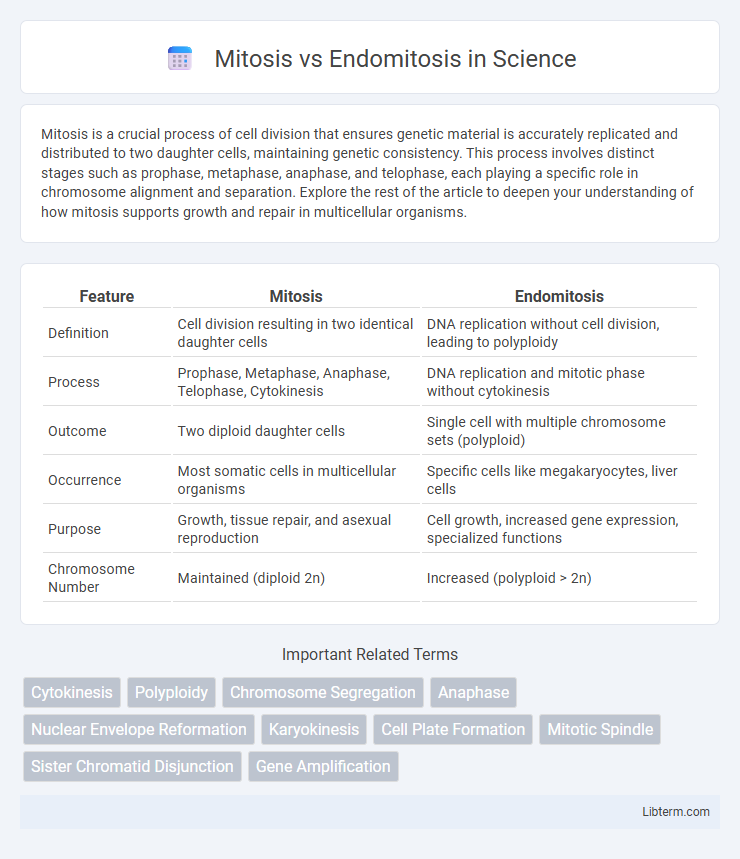Mitosis is a crucial process of cell division that ensures genetic material is accurately replicated and distributed to two daughter cells, maintaining genetic consistency. This process involves distinct stages such as prophase, metaphase, anaphase, and telophase, each playing a specific role in chromosome alignment and separation. Explore the rest of the article to deepen your understanding of how mitosis supports growth and repair in multicellular organisms.
Table of Comparison
| Feature | Mitosis | Endomitosis |
|---|---|---|
| Definition | Cell division resulting in two identical daughter cells | DNA replication without cell division, leading to polyploidy |
| Process | Prophase, Metaphase, Anaphase, Telophase, Cytokinesis | DNA replication and mitotic phase without cytokinesis |
| Outcome | Two diploid daughter cells | Single cell with multiple chromosome sets (polyploid) |
| Occurrence | Most somatic cells in multicellular organisms | Specific cells like megakaryocytes, liver cells |
| Purpose | Growth, tissue repair, and asexual reproduction | Cell growth, increased gene expression, specialized functions |
| Chromosome Number | Maintained (diploid 2n) | Increased (polyploid > 2n) |
Overview of Mitosis and Endomitosis
Mitosis is a cellular process in which a single cell divides to produce two genetically identical daughter cells, ensuring accurate chromosome segregation through stages including prophase, metaphase, anaphase, and telophase. Endomitosis involves DNA replication without subsequent cell division, resulting in polyploid cells with multiple sets of chromosomes, often observed in specialized cells like megakaryocytes. Both processes maintain genomic integrity but differ fundamentally in cell cycle progression and chromosome segregation.
Definition and Fundamental Differences
Mitosis is a process of nuclear division in eukaryotic cells resulting in two genetically identical daughter cells, essential for growth and tissue repair. Endomitosis, however, involves replication of the genome without cell division, leading to polyploid cells with multiple chromosome sets. The fundamental difference lies in mitosis completing cytokinesis, while endomitosis stops after DNA replication, producing enlarged cells with increased DNA content but no cell proliferation.
Phases of Mitosis Explained
Mitosis consists of four distinct phases: prophase, metaphase, anaphase, and telophase, each orchestrating the precise division of duplicated chromosomes into two daughter cells. Prophase involves chromatin condensation and spindle fiber formation, metaphase aligns chromosomes at the metaphase plate, anaphase separates sister chromatids toward opposite poles, and telophase re-establishes nuclear membranes around the chromosomes. Unlike mitosis, endomitosis bypasses the complete nuclear division, resulting in polyploid cells with multiple chromosome sets retained within a single nucleus.
The Endomitosis Process in Detail
Endomitosis is a modified cell cycle process where the cell undergoes DNA replication without subsequent cytokinesis, resulting in polyploid cells with multiple chromosome sets within a single nucleus. This process involves the duplication of chromosomes during the S phase, but the mitotic phases, especially anaphase and telophase, are incomplete or fail, preventing chromosome segregation and cell division. Endomitosis is crucial in certain cell types, such as megakaryocytes, enabling increased cell size and enhanced gene expression without increasing cell number.
Key Differences in Chromosome Duplication
Mitosis involves complete chromosome duplication followed by nuclear division, ensuring two daughter cells receive identical chromosome sets. Endomitosis features chromosome duplication without subsequent nuclear division, leading to polyploid cells with multiple chromosome copies residing in a single nucleus. This difference impacts cell function, with endomitosis often seen in specialized cells requiring increased DNA content for heightened metabolic activity.
Biological Significance of Each Process
Mitosis ensures genetic stability by producing two identical diploid daughter cells, essential for growth, tissue repair, and asexual reproduction in eukaryotes. Endomitosis generates polyploid cells by replicating DNA without cell division, increasing cell size and metabolic capacity, crucial in specialized tissues like megakaryocytes for platelet production. Both processes are vital for organismal development and adaptation, with mitosis maintaining cellular uniformity and endomitosis enabling functional specialization.
Occurrence in Organisms and Cell Types
Mitosis occurs in a wide range of eukaryotic organisms, primarily in somatic cells responsible for growth and tissue repair, ensuring genetic consistency through cell division. Endomitosis takes place in specific cell types such as megakaryocytes in bone marrow, where DNA replication happens without subsequent cell division, leading to polyploidy. While mitosis is common across many tissues, endomitosis is specialized and limited to cells requiring increased gene expression for functions such as platelet production.
Advantages and Disadvantages
Mitosis ensures genetic stability by producing identical diploid daughter cells, which is essential for growth and tissue repair, but it requires precise regulation to avoid errors that can lead to cancer. Endomitosis increases cell size and DNA content without cell division, benefiting cells requiring high metabolic output, such as megakaryocytes, yet it can cause genomic instability and limit cell proliferation. Both processes balance cellular function with risks: mitosis offers controlled replication, while endomitosis provides specialized differentiation at the cost of potential DNA abnormalities.
Implications in Disease and Medicine
Mitosis ensures equal chromosome segregation during cell division, whereas endomitosis leads to polyploidy, often observed in megakaryocytes and certain cancer cells. The dysregulation of mitosis can cause aneuploidy, a hallmark of many cancers, while abnormal endomitosis contributes to diseases like myeloproliferative disorders. Targeting pathways involved in mitotic checkpoints and polyploidization holds promise for developing novel therapies for cancer and bone marrow-related diseases.
Summary Table: Mitosis vs Endomitosis
The summary table comparing mitosis and endomitosis highlights key differences such as chromosome segregation, cellular division, and DNA replication. Mitosis involves proper chromosome alignment and physical cell division, resulting in two distinct daughter cells, whereas endomitosis entails DNA replication without chromosome segregation or cytokinesis, leading to polyploid cells. Understanding these distinctions is critical for analyzing cellular processes in growth, development, and certain pathological conditions like cancer.
Mitosis Infographic

 libterm.com
libterm.com